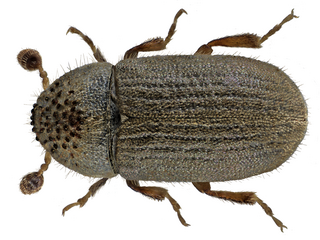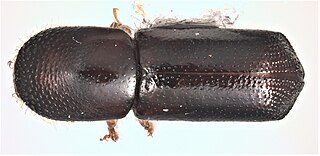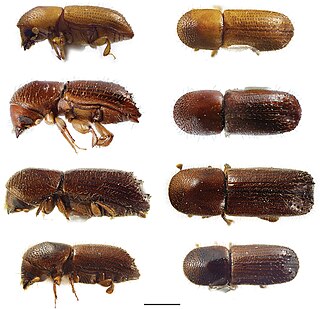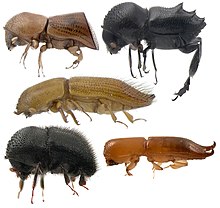Ambrosia beetles are beetles of the weevil subfamilies Scolytinae and Platypodinae, which live in nutritional symbiosis with ambrosia fungi. The beetles excavate tunnels in dead or stressed trees into which they introduce fungal gardens, their sole source of nutrition. After landing on a suitable tree, an ambrosia beetle excavates a tunnel in which it releases its fungal symbiont. The fungus penetrates the plant's xylem tissue, extracts nutrients from it, and concentrates the nutrients on and near the surface of the beetle gallery. Ambrosia fungi are typically poor wood degraders, and instead utilize less demanding nutrients. Symbiotic fungi produce and detoxify ethanol, which is an attractant for ambrosia beetles and likely prevents growth of antagonistic pathogens and selects for other beneficial symbionts. The majority of ambrosia beetles colonize xylem of recently dead trees, but some colonize stressed trees that are still alive, and a few species attack healthy trees. Species differ in their preference for different parts of trees, different stages of deterioration, and in the shape of their tunnels ("galleries"). However, the majority of ambrosia beetles are not specialized to any taxonomic group of hosts, unlike most phytophagous organisms including the closely related bark beetles. One species of ambrosia beetle, Austroplatypus incompertus exhibits eusociality, one of the few organisms outside of Hymenoptera and Isoptera to do so.

A bark beetle is the common name for the subfamily of beetles Scolytinae. Previously, this was considered a distinct family (Scolytidae), but is now understood to be a specialized clade of the "true weevil" family (Curculionidae). Although the term "bark beetle" refers to the fact that many species feed in the inner bark (phloem) layer of trees, the subfamily also has many species with other lifestyles, including some that bore into wood, feed in fruit and seeds, or tunnel into herbaceous plants. Well-known species are members of the type genus Scolytus, namely the European elm bark beetle S. multistriatus and the large elm bark beetle S. scolytus, which like the American elm bark beetle Hylurgopinus rufipes, transmit Dutch elm disease fungi (Ophiostoma). The mountain pine beetle Dendroctonus ponderosae, southern pine beetle Dendroctonus frontalis, and their near relatives are major pests of conifer forests in North America. A similarly aggressive species in Europe is the spruce ips Ips typographus. A tiny bark beetle, the coffee berry borer, Hypothenemus hampei is a major pest on coffee plantations around the world.

Xyleborus is by far the largest ambrosia beetle genus in the tribe Xyleborini, with over 500 species.

Cryphalus is a large genus of tiny bark beetles, subfamily Scolytinae, tribe Cryphalini in the family Curculionidae. The genus is widely distributed. The species feed and breed under the inner bark of trees. They infest mainly recently dead, dying or stressed trees. Some species are regarded as invasive pests, harmful to agriculture or forestry.

Xyleborus glabratus, the redbay ambrosia beetle, is a type of ambrosia beetle invasive in the United States. It has been documented as the primary vector of Raffaelea lauricola, the fungus that causes laurel wilt, a disease that can kill several North American tree species in the family Lauraceae, including redbay, sassafras, and avocado.

Ips is a genus of beetles in the family Curculionidae, the true weevils. They are bark beetles, members of the subfamily Scolytinae. Species are distributed throughout the Northern Hemisphere. Some are known as introduced species in Australia and Africa. Many species are pests of forest trees, especially pines and spruces. They are known commonly as engraver beetles, ips engraver beetles, and pine engravers.
Coptodryas is a genus of ambrosia beetles in the tribe Xyleborini.

Euwallacea fornicatus, also known as tea shot-hole borer, or polyphagous shot-hole borer (PSHB) is a species complex consisting of multiple cryptic species of ambrosia beetles known as an invasive species in California, Israel, South Africa, and Australia. The species has also been unintentionally introduced into exotic greenhouses in several European countries.

Scolytini is a tribe of typical bark beetles in the family Curculionidae. There are at least 50 genera and 160 described species in Scolytini.

Xylosandrus is a genus of beetles with approximately 54 species globally. The type species is Xyleborus morigerus (Blandford) 1894.

Xyleborus affinis, the sugarcane shot-hole borer, is a species of ambrosia beetle in the family Curculionidae. It is found on all continents with woodlands and is one of the most widespread ambrosia beetles internationally, primarily in areas with humid tropical climates like Florida. Like other ambrosia beetles, Xyleborus affinis is attracted to dead fallen logs in early stages of decay. Due to the presence of X. affinis on moist timber, this species is mistakenly believed to be the cause of tree death. However, there is insufficient evidence to support their presence as a causal factor. Rather, these beetles are believed to target and accelerate the decay process of trees that are already deteriorated and weak.

Xyleborinus saxesenii, commonly known as the fruit-tree pinhole borer, is a species of ambrosia beetle in the family Curculionidae. It is native to the Palaearctic region but has been introduced in many locations, including North America. X. saxesenii typically live in freshly dead wood, but it has also been reported to attack live trees. Such attacks on live trees may lead to economic damage.

Euwallacea interjectus is a species of ambrosia beetle in the species complex called Euwallacea fornicatus. It is native to Asia but has been introduced to the Western hemisphere over the last century.
Xyleborinus andrewesi, is a species of weevil widely distributed throughout the Old World tropics and introduced to many New World countries.
Xylosandrus discolor, is a species of weevil found in Australia, Micronesia, Myanmar, China, India, Sri Lanka, Indonesia, Malaysia, Taiwan and Thailand.

Xylosandrus morigerus, is a species of weevil widespread throughout Afrotropical, Australian, Neotropical, Oceania and Oriental regions. It is also introduced to Palearctic regional countries.
Arixyleborus malayensis, is a species of weevil found in India, Sri Lanka, China, Japan, Malaysia, Vietnam and Indonesia. This is the only species of Arixyleborus found in Japan and China.
Ambrosiella roeperi is the fungal symbiont of the granulate ambrosia beetle, Xylosandrus crassiusculus, facilitating this insect’s capacity to accumulate on and damage a diverse array of woody plants from around the world. It is one of several important nutritional partners derived from order Microascales that sustain and are transported by xylomycetophagous scolytine beetles.

Euwallacea is a genus of typical bark beetles in the family Curculionidae. They are commonly known as Ambrosia beetles, as all species are symbiotic with Ambrosia fungi. Originally from Asia or Wallacea, they are now found worldwide. Many species are pests, causing damage to, or the death of, tree species valued for their fruit or timber.













